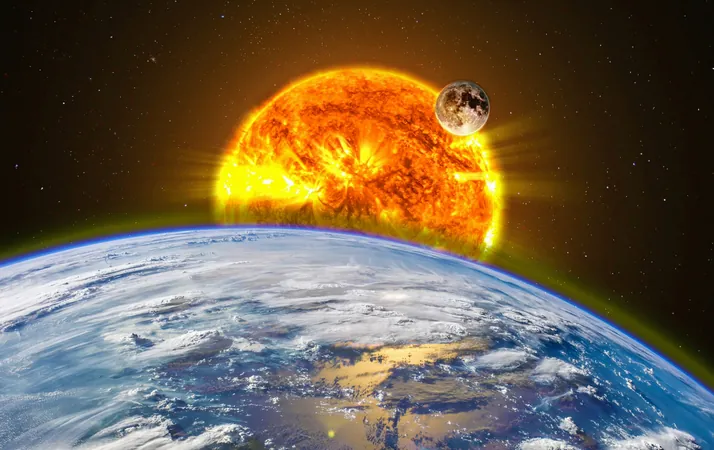
Could the Next Major Solar Storm Leave Us in the Dark? Experts Warn of Potential Catastrophes
2025-01-21
Author: Ken Lee
Understanding Solar Storms and Their Origins
Solar storms originate from solar flares—explosive bursts of electromagnetic radiation and high-energy particles emanating from the Sun. When these particles collide with the Earth's magnetic field, they can create dazzling auroras but also wreak havoc on our technological systems, including power grids and satellites. Experts have observed that the current solar cycle, which is predicted to peak in intensity around 2025, heightens the threat of substantial solar storm activity, intensifying concerns among scientists and engineers alike.
The Dire Implications of a Major Solar Storm
Leading experts, including Dr. Kęstutis Ikamas from Vilnius University, are raising alarms about the vulnerabilities in national power infrastructures, particularly in expansive countries like the United States and Canada. Dr. Ikamas emphasizes that a potent geomagnetic storm could severely disrupt essential services, leading to widespread blackouts, communication failures, and logistical nightmares. In worst-case scenarios, communities could experience outages that last for months.
Historical precedents underscore these risks. The infamous Carrington Event of 1859 caused massive disruptions to telegraph systems across continents—a minor incident compared to today’s interconnected, technology-dependent society. More recently, a solar storm in 2022 resulted in the destruction of 40 Starlink satellites shortly after their launch, showcasing the immediate threats posed to modern technology.
The Dangers of Extended Power Grids
Dr. Ikamas explains that extensive electricity networks are particularly vulnerable to fluctuations in voltage induced by solar storms. A sudden influx of charged particles can damage transformers, threatening the stability of entire power grids. Although some protective systems are in place, their efficacy against a catastrophic solar storm is uncertain. Financial considerations often lead utility organizations to postpone necessary upgrades, despite their vital importance.
The National Oceanic and Atmospheric Administration (NOAA) categorizes the strength of geomagnetic storms using a scale from G1 to G5, with increasing severity at each level. At the highest levels of intensity, solar storms can disrupt everything from local radio communications to global satellite networks.
A Broader Threat Horizon: Space Travelers and Wildlife
The implications of solar storms extend beyond Earthbound systems. Astronauts on missions outside of our planet’s protective magnetic shield could face increased radiation exposure during solar events, potentially necessitating changes to operational schedules to ensure safety.
Moreover, wildlife, particularly migratory species that depend on Earth's magnetic fields for navigation, may deviate from their normal routes during periods of heightened solar activity. Studies have documented erratic migration behaviors in birds and marine creatures correlating with solar storm activities.
Urgency for Global Collaboration
Dr. Ikamas contends that tackling the threats of solar storms requires not just individual or isolated actions but a concerted, cooperative effort on a global scale. He advocates for collaboration among technology producers, utility companies, and governments to establish effective response protocols that can be enacted at a moment's notice when solar storm alerts are issued.
He further likens the necessary investments for enhanced protective measures to insurance premiums—an upfront cost that may seem steep but could save trillions in potential losses during a crisis.
As ever-expanding digital networks connect us like never before, local outages can have cascading effects globally. Dr. Ikamas warns that neglecting grid upgrades today could lay the groundwork for widespread chaos in the future.
The Rarity and Potential Impact of Solar Storms
While major solar storms are not commonplace, the likelihood of a significant storm impacting Earth in the coming years has sparked urgent discussions among scientists, policymakers, and energy companies.
In the event of a detected strong storm, Dr. Ikamas advises individuals to unplug their devices to safeguard them from possible surges. He highlights a pressing need for worldwide reforms in protective infrastructure, asserting that proactive measures are crucial to avoiding likely disasters in the near future.
Stay alert—because the next solar storm could be just around the corner!



 Brasil (PT)
Brasil (PT)
 Canada (EN)
Canada (EN)
 Chile (ES)
Chile (ES)
 Česko (CS)
Česko (CS)
 대한민국 (KO)
대한민국 (KO)
 España (ES)
España (ES)
 France (FR)
France (FR)
 Hong Kong (EN)
Hong Kong (EN)
 Italia (IT)
Italia (IT)
 日本 (JA)
日本 (JA)
 Magyarország (HU)
Magyarország (HU)
 Norge (NO)
Norge (NO)
 Polska (PL)
Polska (PL)
 Schweiz (DE)
Schweiz (DE)
 Singapore (EN)
Singapore (EN)
 Sverige (SV)
Sverige (SV)
 Suomi (FI)
Suomi (FI)
 Türkiye (TR)
Türkiye (TR)
 الإمارات العربية المتحدة (AR)
الإمارات العربية المتحدة (AR)